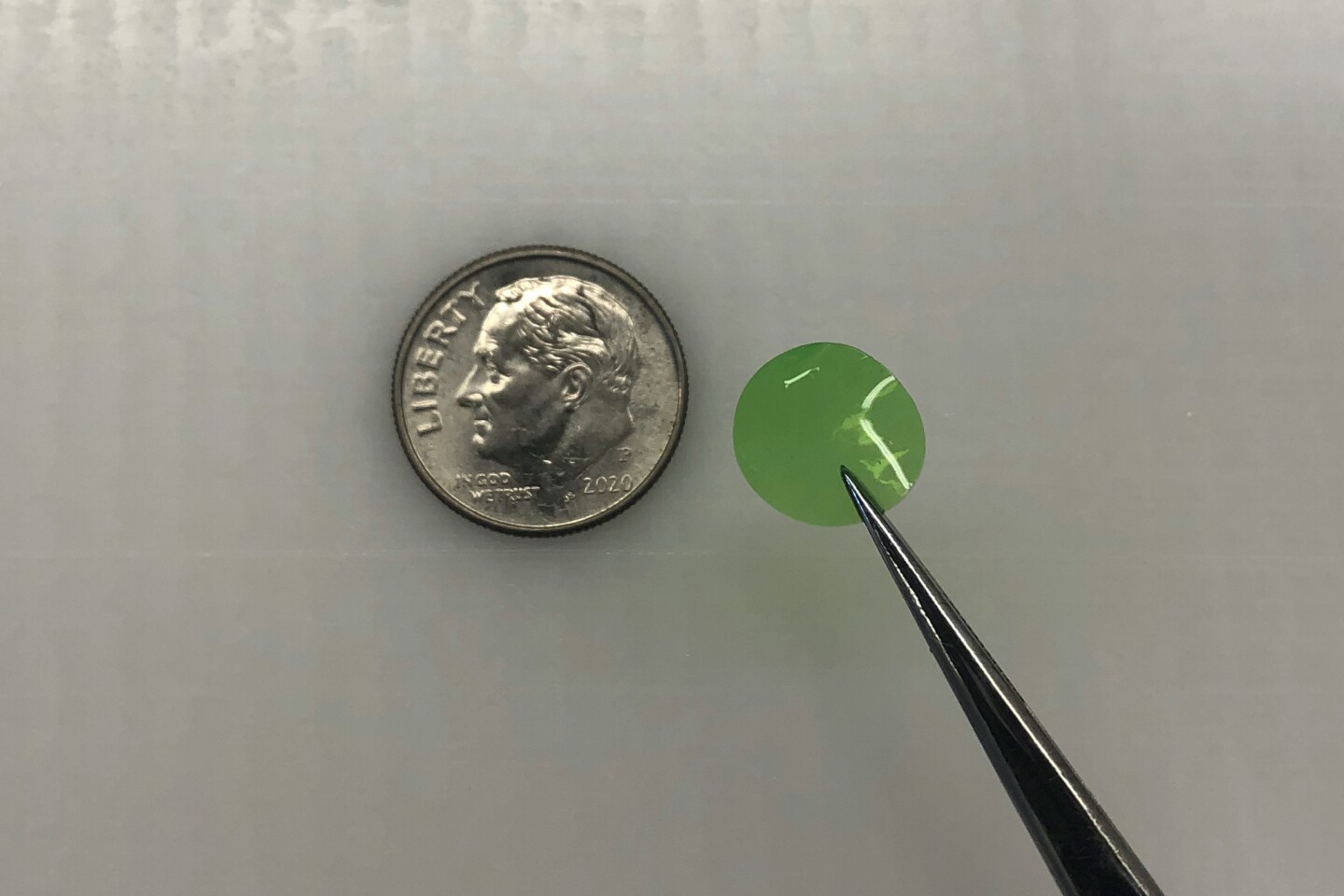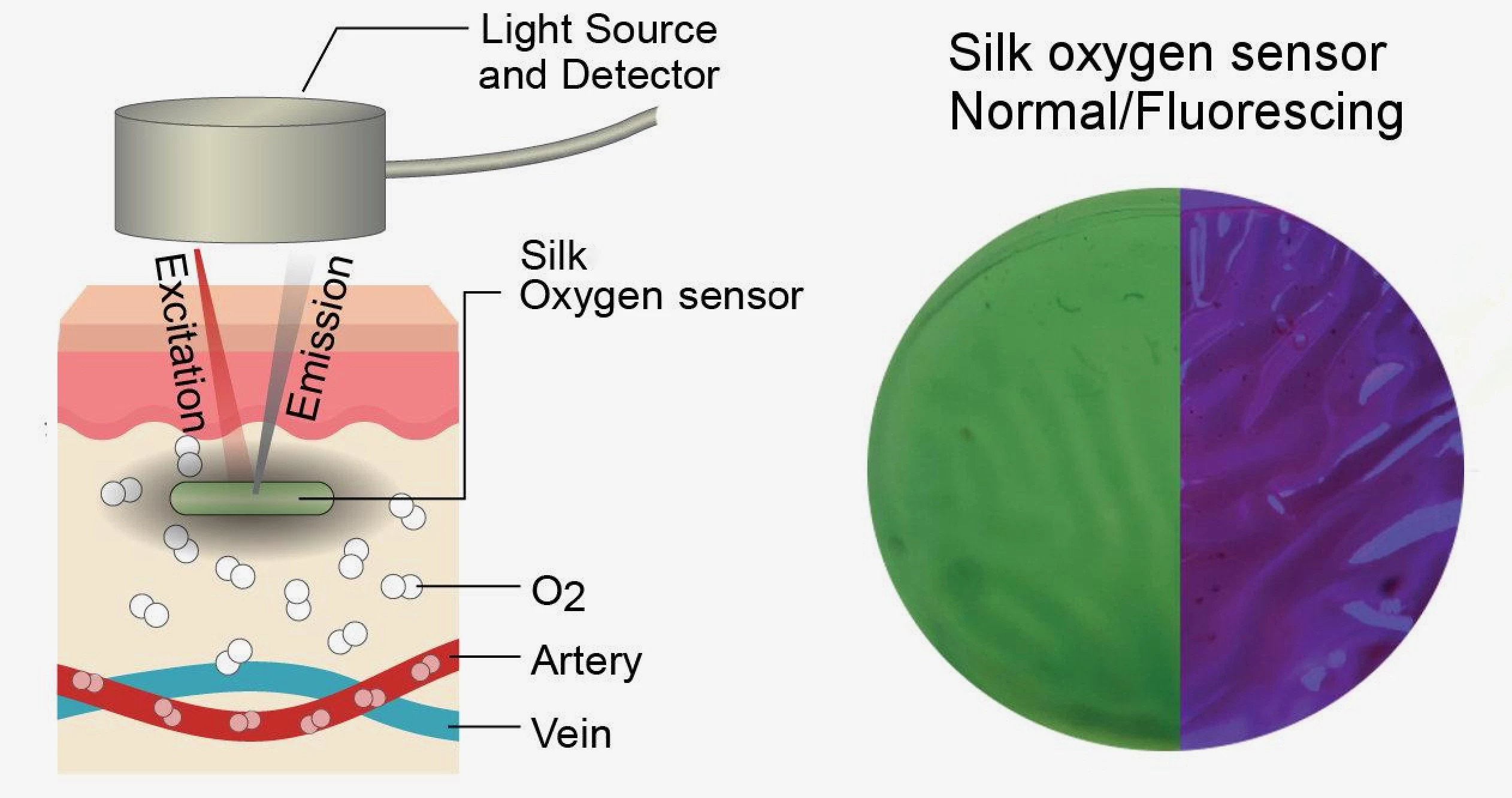Monitoring blood oxygen levels is important when treating patients with certain illnesses, including COVID-19. Now, a new subcutaneous light-sensitive sensor offers a way to do just that, and could one day be used to measure other substances in the blood as well.

The technology is being developed in the lab of Professor David Kaplan at Tufts University in Massachusetts. It currently takes the form of a thin film disc smaller than a U.S. dime that is surgically inserted just below the surface of the skin -- a bit like a tattoo.
The film consists of a permeable gel composed mainly of cellulose, a protein extracted from silk. It is not only biodegradable and biocompatible, but also does not change the chemical properties of the substances added to it.
In this latest study, that substance is a compound called PdBMAP, which glows when exposed to near-infrared light—and the more oxygen there is in the surrounding environment, the shorter the glow. Depending on how it's made, the sensor will dissolve harmlessly in the body over a period of weeks to a year.
In testing the device, the scientists inserted the sensor into the skin of a mouse and then shone near-infrared light through the mouse's skin toward that location. The sensor responded by glowing for a duration that accurately represented the oxygen level of the interstitial fluid surrounding it -- a fluid whose oxygen level mirrors that of the blood.
Although blood oxygen levels can already be measured noninvasively using pulse oximeters, the researchers hope that further development of the sensor technology could allow it to measure other substances in the blood, such as glucose, lactate or electrolytes. Currently, such measurements can only be made through blood samples or by connecting the patient to complex equipment.
"We can envision many situations where tattoo-like sensors under the skin could be useful," said Thomas Falcucci, a graduate student in Kaplan's lab who developed the device. "This would typically be in situations where people with chronic conditions need to be monitored long-term outside of a traditional clinical setting. It could be possible to use an array of sensors under the skin to track multiple blood components."
It is reported that this research has been recently published in Advanced Materials.
Previous article:Scientists integrate new sensor into adult diapers for bedside urine testing
Next article:Helfie.ai provides fast, simple and accurate remote screening for COVID-19 via smartphone
- Popular Resources
- Popular amplifiers
- Chen Han from Rouling Technology: Bringing small, flexible brain-computer interface sleep devices to every household
- Li Xiaojian of Weiling Medical: Brain-computer interface technology is opening a new era of integration of consciousness and AI
- Geng Dong of Jingyu Medical: Brain-computer interface DBS treatment technology has achieved domestic substitution
- Wang Changming from Capital Medical University: Digital therapy for epilepsy has entered the use stage
- Shi Chunbo of Qianqiu Intelligent: Using digital therapy to illuminate the light of children with autism
- Feng Shang, Digital Medicine Intelligence: ADHD digital therapy is providing more effective and convenient services for children with ADHD
- Ultrasound patch can continuously and noninvasively monitor blood pressure
- High-speed 3D bioprinter is available, using sound waves to accurately build cell structures in seconds
- [“Source” Observation Series] Application of Keithley in Particle Beam Detection Based on Perovskite System
- Intel promotes AI with multi-dimensional efforts in technology, application, and ecology
- ChinaJoy Qualcomm Snapdragon Theme Pavilion takes you to experience the new changes in digital entertainment in the 5G era
- Infineon's latest generation IGBT technology platform enables precise control of speed and position
- Two test methods for LED lighting life
- Don't Let Lightning Induced Surges Scare You
- Application of brushless motor controller ML4425/4426
- Easy identification of LED power supply quality
- World's first integrated photovoltaic solar system completed in Israel
- Sliding window mean filter for avr microcontroller AD conversion
- What does call mean in the detailed explanation of ABB robot programming instructions?
- STMicroelectronics discloses its 2027-2028 financial model and path to achieve its 2030 goals
- 2024 China Automotive Charging and Battery Swapping Ecosystem Conference held in Taiyuan
- State-owned enterprises team up to invest in solid-state battery giant
- The evolution of electronic and electrical architecture is accelerating
- The first! National Automotive Chip Quality Inspection Center established
- BYD releases self-developed automotive chip using 4nm process, with a running score of up to 1.15 million
- GEODNET launches GEO-PULSE, a car GPS navigation device
- Should Chinese car companies develop their own high-computing chips?
- Infineon and Siemens combine embedded automotive software platform with microcontrollers to provide the necessary functions for next-generation SDVs
- Continental launches invisible biometric sensor display to monitor passengers' vital signs
- [GD32L233C-START Review] 13. CAU encryption algorithm DES/TDES
- Wireless Sensor Network Overview
- [Silicon Labs BG22-EK4108A Bluetooth Development Evaluation] 3. Lighting Experiment
- CC1310 Two-wire Serial Bootloader Solution
- Huawei mobile phone case fill light
- Filter applications for different scenarios - harmonics
- The principle and application of battery fuel gauge and charger chip DS2770
- 4.3-inch screen design
- Calculation of IM3, IIP3, OIP3, etc.
- EEWORLD University Hall----Live playback: Gigabit digital isolators for video, converters, and communications


 OP17AZ
OP17AZ
















 京公网安备 11010802033920号
京公网安备 11010802033920号